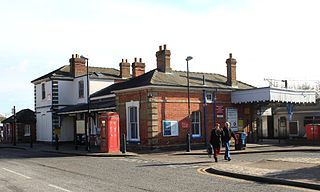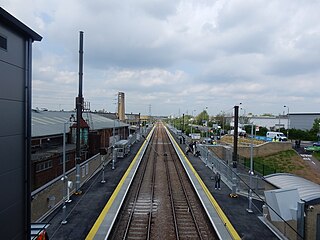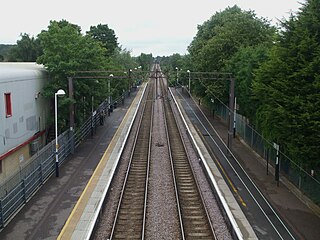
The Great Eastern Main Line is a 114.5-mile (184.3 km) major railway line on the British railway system which connects Liverpool Street station in central London with destinations in east London and the East of England,including Shenfield,Chelmsford,Colchester,Ipswich and Norwich. Its numerous branches also connect the main line to Southminster,Braintree,Sudbury,Harwich and a number of coastal towns including Southend-on-Sea,Clacton-on-Sea,Walton-on-the-Naze and Lowestoft.

Romford railway station is an interchange station on the Great Eastern Main Line,serving the town of Romford in the London Borough of Havering,east London. It is 12 miles 30 chains (19.9 km) down the line from London Liverpool Street and is situated between Chadwell Heath and Gidea Park. It is also the northern terminus of a branch line to Upminster operated by London Overground. Its three-letter station code is RMF and it is in Travelcard Zone 6.

Chadwell Heath railway station is on the Great Eastern Main Line in Chadwell Heath,which straddles the London Borough of Redbridge and the London Borough of Barking and Dagenham in East London. It is 9 miles 79 chains (16.1 km) down the line from London Liverpool Street and is situated between Goodmayes and Romford. Its three-letter station code is CTH and it is in Travelcard Zone 5.

Norwich railway station is the northern terminus of the Great Eastern Main Line in the East of England,serving the cathedral city of Norwich,Norfolk. It is 114 miles 77 chains (185.0 km) down the main line from London Liverpool Street,the western terminus.

Cheshunt is a National Rail and London Overground station in Cheshunt,Hertfordshire,England. On the National Rail network it is on the West Anglia Main Line,14 miles 1 chain (22.6 km) from London Liverpool Street and situated between Waltham Cross and Broxbourne. On the London Overground network it is one of three northern termini of the Lea Valley lines.

The Braintree branch line is a railway branch line in the East of England that diverges from the Great Eastern Main Line at Witham and runs north-west to Braintree. The route is 6 miles 30 chains (10.3 km) in length and there are five stations,including the two termini. The line is part of Network Rail Strategic Route 7,SRS 07.06,and is classified as a London and South-East commuter line.

Braintree railway station is the northern terminus of the Braintree Branch Line in the East of England,serving the town of Braintree,Essex. It is 44 miles 78 chains (72.38 km) down the line from London Liverpool Street via Witham;the preceding station on the route is Braintree Freeport to the south.

Braintree Freeport railway station is on the Braintree Branch Line in the East of England,serving the Braintree Village shopping centre. It is 44 miles 16 chains (71.13 km) down the line from London Liverpool Street via Witham and it is situated between Cressing to the south and Braintree to the north. Its three-letter station code is BTP. The platform has an operational length for eight-coach trains.

Witham railway station is on the Great Eastern Main Line (GEML) in the East of England,serving the town of Witham,Essex. It is situated about half a mile (1 km) from the north of the town centre and is 38 miles 48 chains (62.1 km) down the line from London Liverpool Street. On the GEML,Witham is situated between Hatfield Peverel to the west and Kelvedon to the east. It is the junction for the Braintree Branch Line to the north-west,which opened in 1848;between 1848 and 1964,it was also the junction for a south-east-facing branch line to Maldon. Its three-letter station code is WTM.

Shenfield railway station is on the Great Eastern Main Line in the East of England,serving the town of Shenfield,Essex. As well as being a key interchange for medium- and long-distance services on the main line,it is also the western terminus of a branch line to Southend Victoria and one of the two eastern termini of the Elizabeth line. It is 20 miles 16 chains (32.51 km) down the line from Liverpool Street and is situated between Brentwood and either Ingatestone on the main line or Billericay on the branch line. Its three-letter station code is SNF.

The Crouch Valley line is a branch line off the Shenfield–Southend line in Essex,in the east of England. It links Wickford in the west to Southminster in the east. During peak hours,trains connect to or from the Great Eastern Main Line at Shenfield,and its London terminus at Liverpool Street.

Lea Bridge is a railway station on the line between Stratford and Tottenham Hale on the Lea Valley Lines,which reopened on 15 May 2016 with the full service beginning on 16 May 2016,operated by Greater Anglia.

Wickford railway station is on the Shenfield to Southend Line and is also the western terminus of the Crouch Valley Line in the east of England,serving the town of Wickford in the Basildon district of Essex. It is 29 miles 2 chains (46.71 km) down the line from London Liverpool Street and is situated between Billericay to the west and,to the east,Rayleigh on the Southend Line and Battlesbridge on the Crouch Valley Line. The Engineer's Line Reference for the line is SSV,the station's three-letter station code is WIC.

South Woodham Ferrers railway station is on the Crouch Valley Line in the East of England,serving the town of South Woodham Ferrers,Essex. It is 34 miles (55 km) down the line from London Liverpool Street and is situated between Battlesbridge to the west and North Fambridge to the east. Train services are operated by Greater Anglia.

White Notley railway station is on the Braintree Branch Line in the East of England,serving the village of White Notley,Essex. It is 41 miles 60 chains (67.19 km) down the line from London Liverpool Street and it is situated between Witham to the south and Cressing to the north. Its three-letter station code is WNY. The platform has an operational length for twelve-coach trains. In 2018/19 it was the least used station in Essex.

The Chingford branch line is a railway line between Clapton Junction and Chingford station. Services operate between Liverpool Street station and Chingford. The branch is part of the London Overground.
The Bishop's Stortford–Braintree branch line was an 18-mile-long (29 km) railway line connecting existing railways at Bishop's Stortford,Dunmow and Braintree. It was promoted independently by the Bishop’s Stortford,Dunmow and Braintree Railway (BSD&BR) company,but the directors failed to generate subscriptions,or to manage the construction properly. The Great Eastern Railway was the dominant railway company in the area,and saw the line as a blocker,to prevent the incursion of a rival line,so they felt obliged to support it. However they themselves had other pressing priorities,both managerial and financial,at the time,and for some time the construction was in abeyance.
The Witham to Maldon branch line is a closed railway line joining Maldon to the British railway network at Witham in Essex,England. It was opened in 1848 and was 5+3⁄4 miles (9 km) long. It was extended to Woodham Ferris to give direct access to Southend-on-Sea,but that extension was not commercially successful.

Maldon East and Heybridge railway station served the town of Maldon and village of Heybridge in Essex,England. It was opened in 1848 by the Maldon,Witham &Braintree Railway (MWBR) on a branch line from Witham to Maldon. It was originally named Maldon but was renamed Maldon East in 1889 and then Maldon East and Heybridge in 1907.
The Enfield Town branch is a suburban branch line in the England. In 2014 it is in fact the combination of the original Enfield branch which was built in 1849 by the Eastern Counties Railway (ECR) and a later line built by the Great Eastern Railway (GER) from Hackney Downs to Edmonton in 1872. The line is currently a double-tracked suburban railway with services running between Liverpool Street station and Enfield Town as well as some other services running from Liverpool Street to Cheshunt. Part of the original branch is closed and little visible remains today.

















